iclicker questions
0.0(0)
Card Sorting
1/66
Earn XP
Description and Tags
Study Analytics
Name | Mastery | Learn | Test | Matching | Spaced |
|---|
No study sessions yet.
67 Terms
1
New cards

which statements are true regarding induced flow on a light twin airplane and the associated operational considerations?
a. induced flow causes the greatest amount of lift to be located on the wing behind the propellers
d. rapidly adding power immediately increases induced flow and lift
e. if you reduce power abruptly at a slow airspeed, the corresponding loss of lift could result in a high sink rate or stall
d. rapidly adding power immediately increases induced flow and lift
e. if you reduce power abruptly at a slow airspeed, the corresponding loss of lift could result in a high sink rate or stall
2
New cards
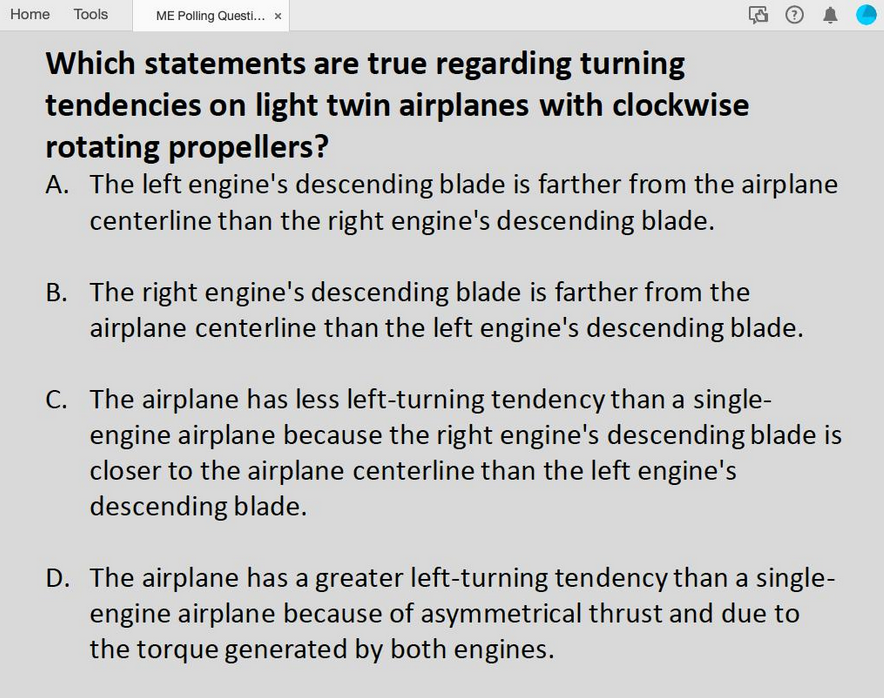
which statements are true regarding turning tendencies on light twin airplanes with clockwise rotating propellers?
b. the right engine’s descending blade is farther from the airplane centreline than the left engine’s descending blade.
d. the airplane has a greater left-turning tendency than a single-engine airplane because of asymmetrical thrust and due to the torque generated by both engines
d. the airplane has a greater left-turning tendency than a single-engine airplane because of asymmetrical thrust and due to the torque generated by both engines
3
New cards
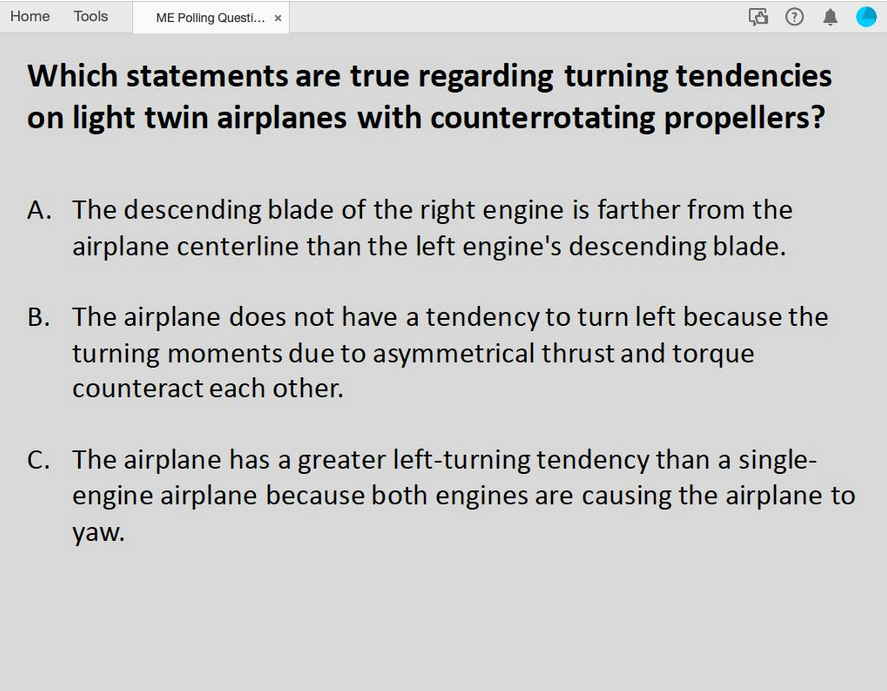
which statements are true regarding tendencies on light twin airplanes with counterrotating propellers?
b. the airplane does not have a tendency to turn left because the turning moments due to asymmetrical thrust and torque counteract each other
4
New cards

the right engine fails on a light twin airplane. What statements are true about the yaw and roll caused by this engine failure?
b. %%**induced flow**%% from the propeller slipstream is lost on the right wing, so total lift on that wing is decreased, while the induced airflow form the left engine is still producing additional lift. this lift differential results in a roll towards the right
c. the plane yaws to the right because the left engine is still producing thrust
e. %%**drag,**%% created by the windmilling propeller of the right engine, contributes to the roll and yaw toward the engine
c. the plane yaws to the right because the left engine is still producing thrust
e. %%**drag,**%% created by the windmilling propeller of the right engine, contributes to the roll and yaw toward the engine
5
New cards
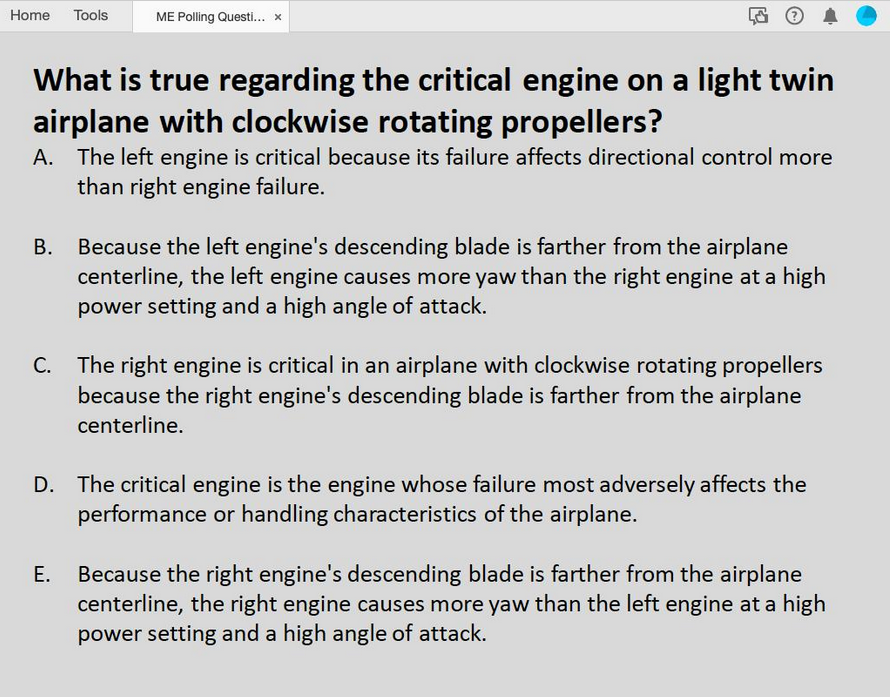
what is true regarding the critical engine on a light twin airplane with clockwise rotating propellers
a. the left engine is critical because its failure **affects directional control** more than right engine failure
d. the critical engine is the engine **whose failure most adversely affects** the performance or handling characteristics of the airplane
e. because the right engine’s descending blade is farther from the airplane centreline, the right engine causes more yaw than the left engine at a high power setting and a high angle of attack
d. the critical engine is the engine **whose failure most adversely affects** the performance or handling characteristics of the airplane
e. because the right engine’s descending blade is farther from the airplane centreline, the right engine causes more yaw than the left engine at a high power setting and a high angle of attack
6
New cards
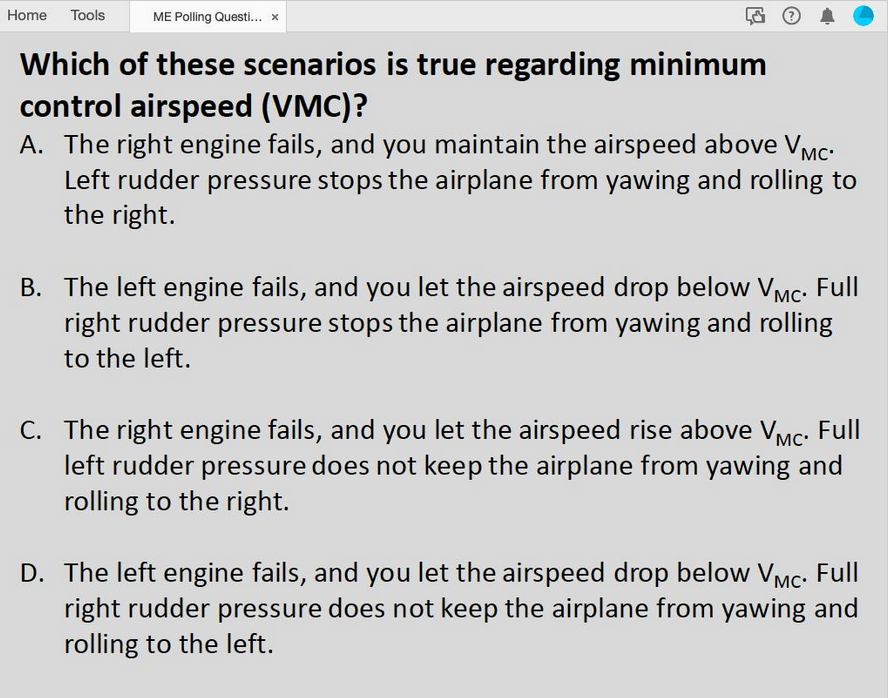
which of these scenarios is true regarding minimum control airspeed (V**mc**)?
a. the right engine fails, and you maintain the airspeed above **Vmc.** left rudder pressure stops the plane from yawing and rolling to the right
d. the left engine fails, and you let the airspeed drop below **Vmc.** full right engine pressure does not keep the airplane from yawing and rolling to the left
d. the left engine fails, and you let the airspeed drop below **Vmc.** full right engine pressure does not keep the airplane from yawing and rolling to the left
7
New cards
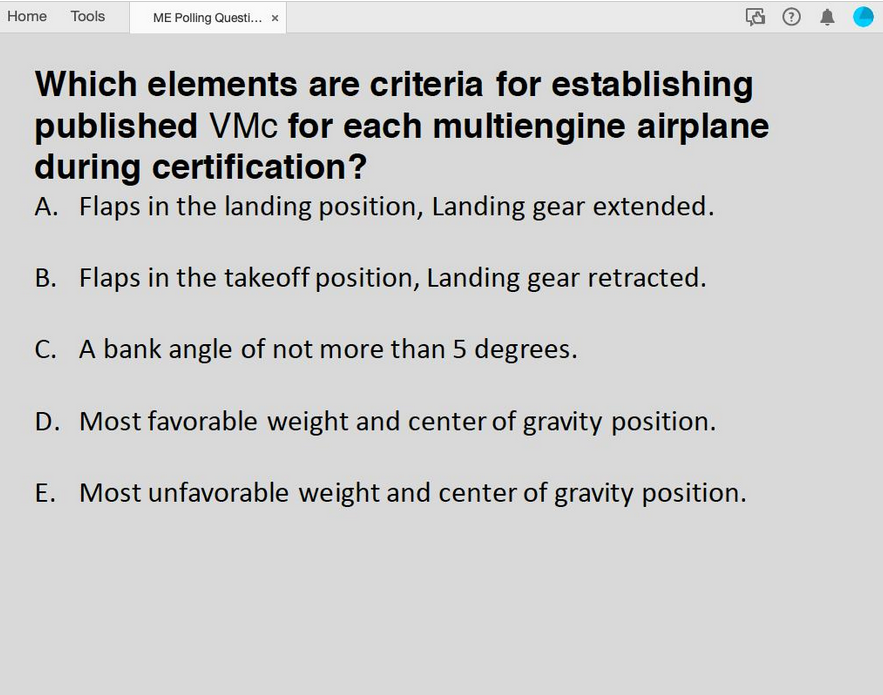
which elements are criteria for establishing published V**mc** for each multiengine airplane during certification?
b. flaps in the takeoff position, landing gear retracted
c. a bank angle of not more than 5 degrees
e. most unfavourable weight and centre of gravity position
c. a bank angle of not more than 5 degrees
e. most unfavourable weight and centre of gravity position
8
New cards
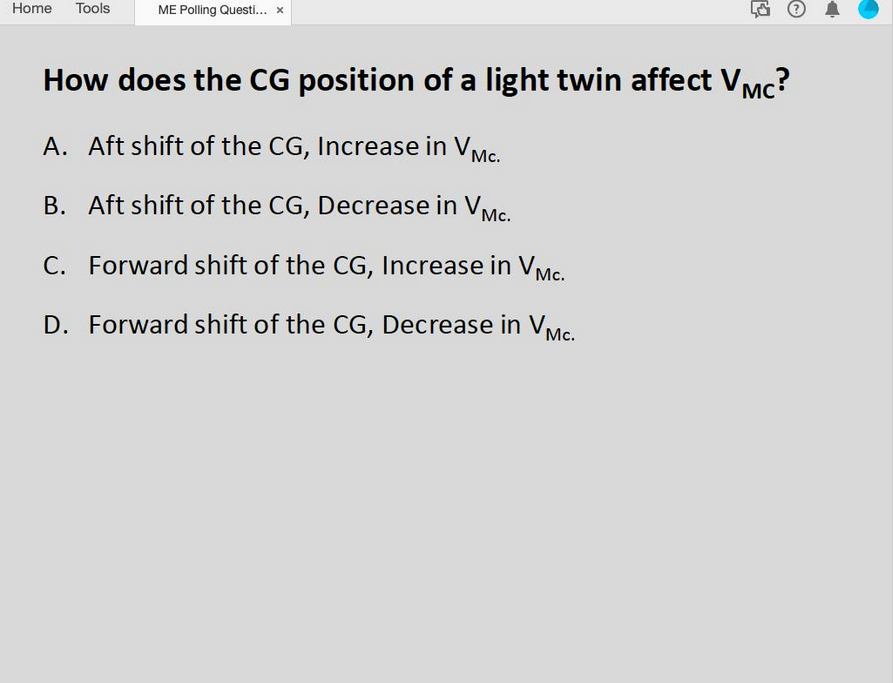
how does CG position of a light twin affect Vmc?
a. aft shift of the CG, increase in V**mc**
d. forward shift of the CG, decrease in V**mc**
d. forward shift of the CG, decrease in V**mc**
9
New cards
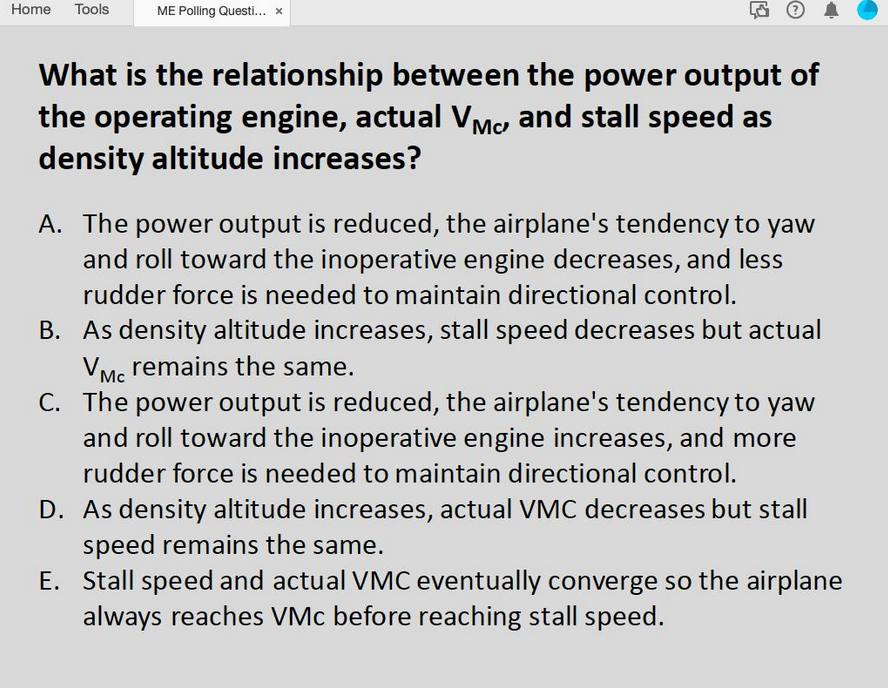
what is the relationship between the power output of the operating engine, actual Vmc, and stall speed as density altitude increases?
a. the power output is reduced, the airplane’s tendency to yaw and roll towards the inoperative engine decreases, and less rudder force is needed to maintain directional control
d. as density altitude increases, actual V**mc** decreases but stall speed remains the same
d. as density altitude increases, actual V**mc** decreases but stall speed remains the same
10
New cards
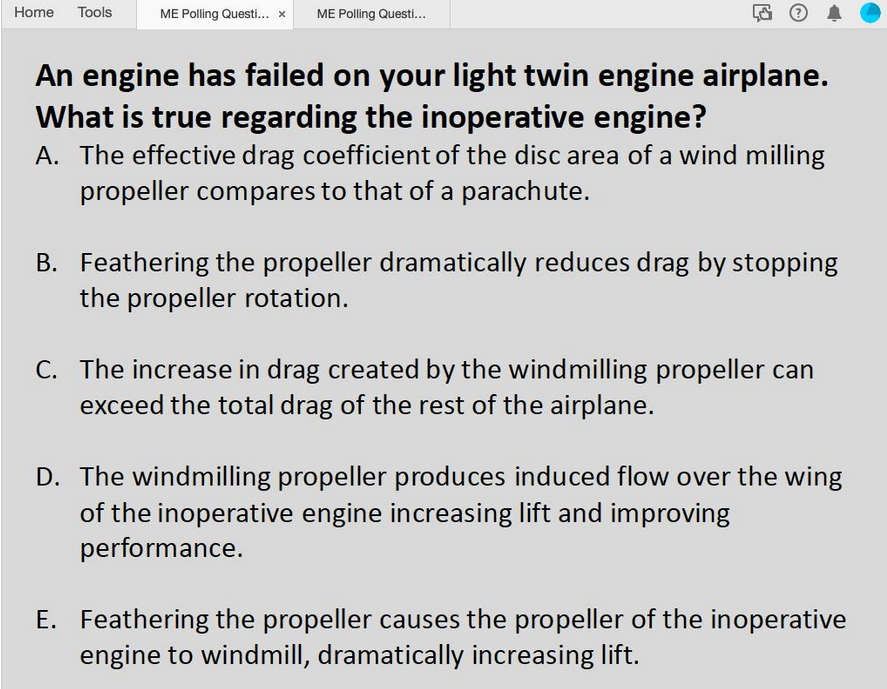
an engine has failed on your light twin engine airplane. what is true regarding the inoperative engine?
a. the power output is reduced, the airplane’s tendency to yaw and roll towards the inoperative engine decreases, and less rudder force is needed to maintain directional control
d. as %%**density altitude**%% increases, %%**actual** **Vmc**%% decreases but %%**stall speed**%% remains the same
d. as %%**density altitude**%% increases, %%**actual** **Vmc**%% decreases but %%**stall speed**%% remains the same
11
New cards
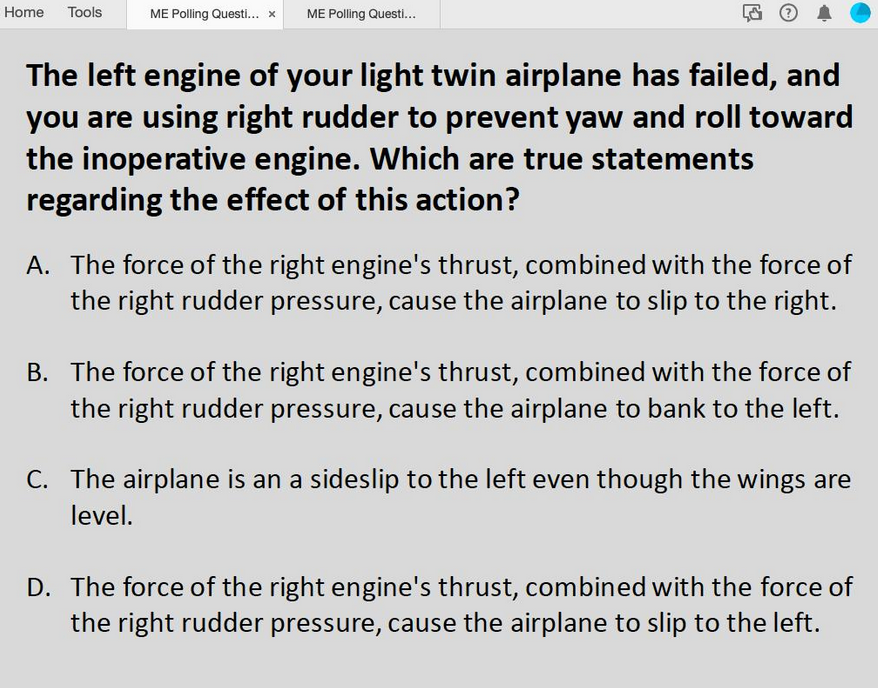
the **left engine** of your light twin airplane has failed, and you are using right rudder to prevent yaw and roll toward the inoperative engine. which are **true statements** regarding the effect of this action?
c. the airplane is in a sideslip to the left even though the wings are level
d. the force of the right engine’s thrust, combined with the force of the right rudder pressure, cause the airplane to slip to the left
d. the force of the right engine’s thrust, combined with the force of the right rudder pressure, cause the airplane to slip to the left
12
New cards

what are **sideslip’s** effects on the controllability and performance of a light twin after an engine failure?
b. you might have to use a higher airspeed than the **published Vmc** to generate sufficient airflow across the rudder to maintain directional control
c. the vertical stabilizer blocks some of the relative wind from reaching the rudder, eroding rudder effectiveness
d. an increase in drag, resulting from the relative wind striking the fuselage at an angle, decreases performance
c. the vertical stabilizer blocks some of the relative wind from reaching the rudder, eroding rudder effectiveness
d. an increase in drag, resulting from the relative wind striking the fuselage at an angle, decreases performance
13
New cards
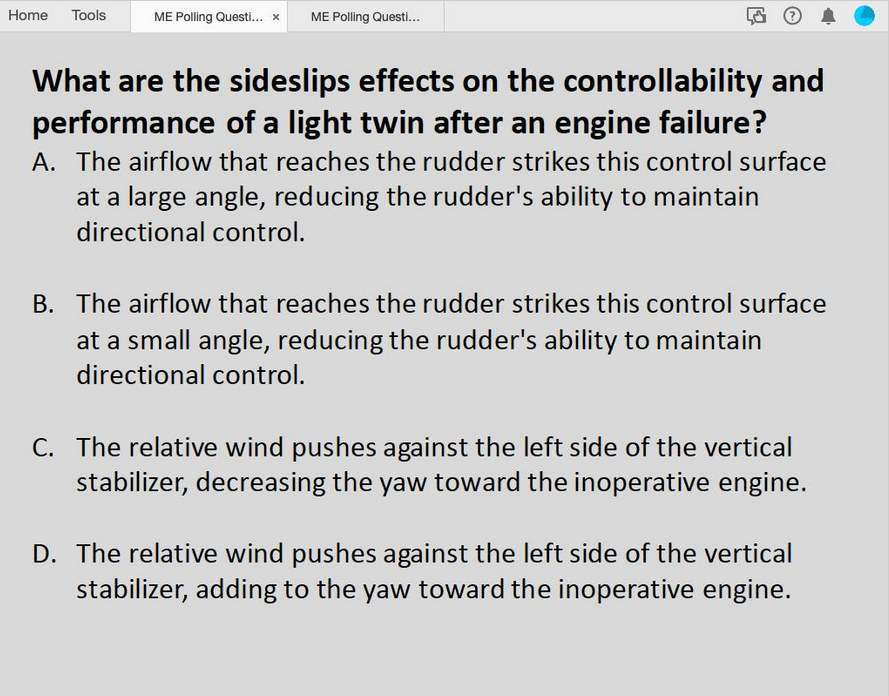
what are **sideslip’s** effects on the controllability and performance of a light twin after an engine failure?
b. the airflow that reaches the rudder strikes this control surface at a small angle, reducing the rudder’s ability to maintain directional control
d. the relative wind pushes against the left side of the vertical stabilizer, adding to the yaw towards the inoperative engine
d. the relative wind pushes against the left side of the vertical stabilizer, adding to the yaw towards the inoperative engine
14
New cards
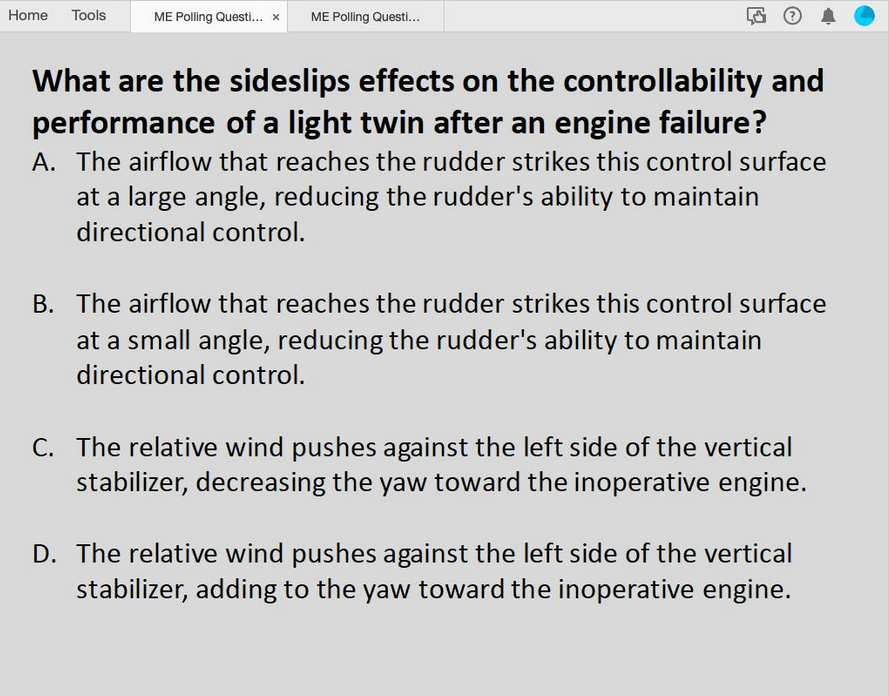
the **right engine** has failed in your light twin airplane. you prevent yawing and rolling towards the inoperative engine by using left rudder. **what action** should you take to prevent the airplane from sideslipping?
a. bank towards the left engine to zero the sideslip and regain lost controllability and performance
15
New cards
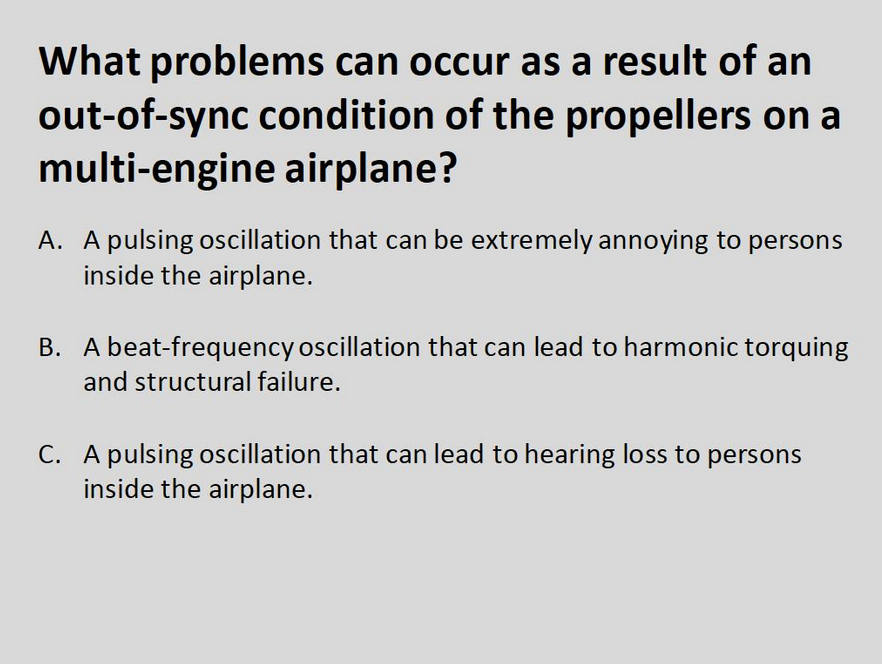
what problems can occur as a result of **an out-of-sync condition** of the propellers on a multi-engine airplane?
a. a pulsing oscillation that can be extremely annoying to persons inside the plane
16
New cards
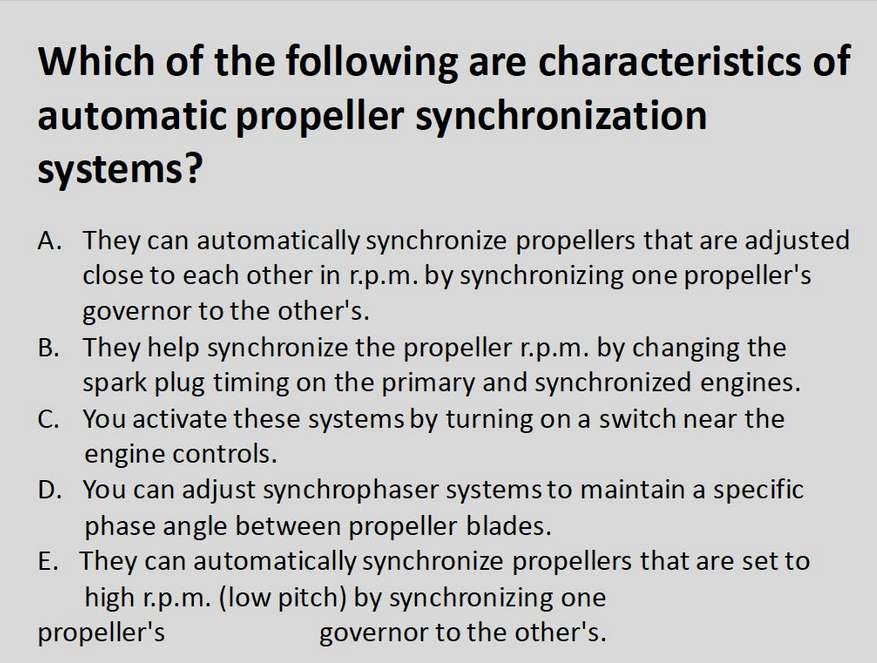
which of the following are **characteristics of the** %%**automatic propeller synchronization systems?**%%
a. they can automatically synchronize propellers that are adjusted close to each other in RPM by synchronizing one propeller’s governor to the other’s
c. you activate these systems by turning on a switch near the engine controls
d. you can adjust synchrophaser systems to maintain a specific phase angle between propeller blades
c. you activate these systems by turning on a switch near the engine controls
d. you can adjust synchrophaser systems to maintain a specific phase angle between propeller blades
17
New cards
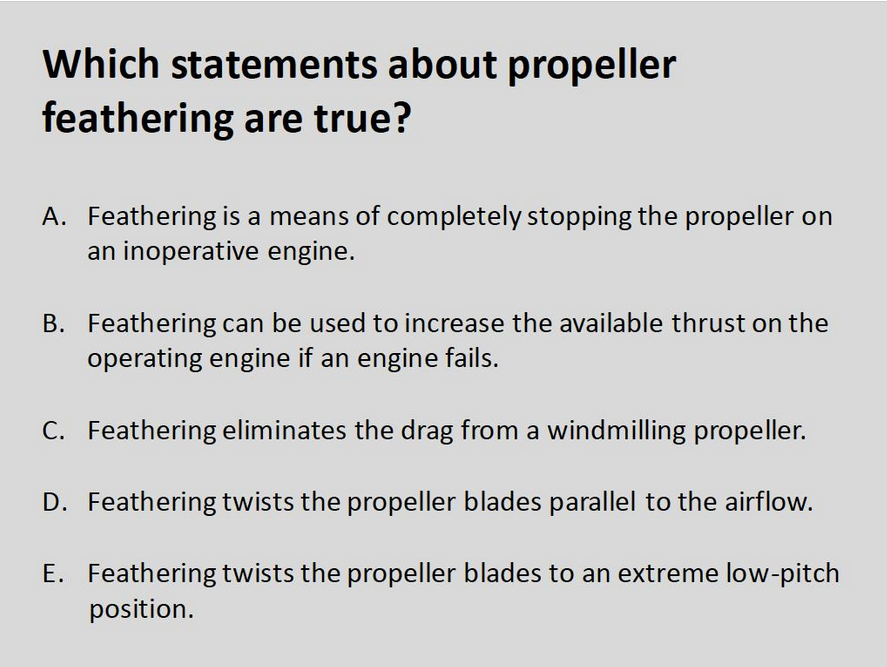
which statements about propeller feathering are **true?**
a. feathering is a means of completely stopping the propeller on an inoperative engine
c. feathering eliminates the drag from a windmilling propeller
d. feathering twists the propeller blades parallel to the airflow
c. feathering eliminates the drag from a windmilling propeller
d. feathering twists the propeller blades parallel to the airflow
18
New cards
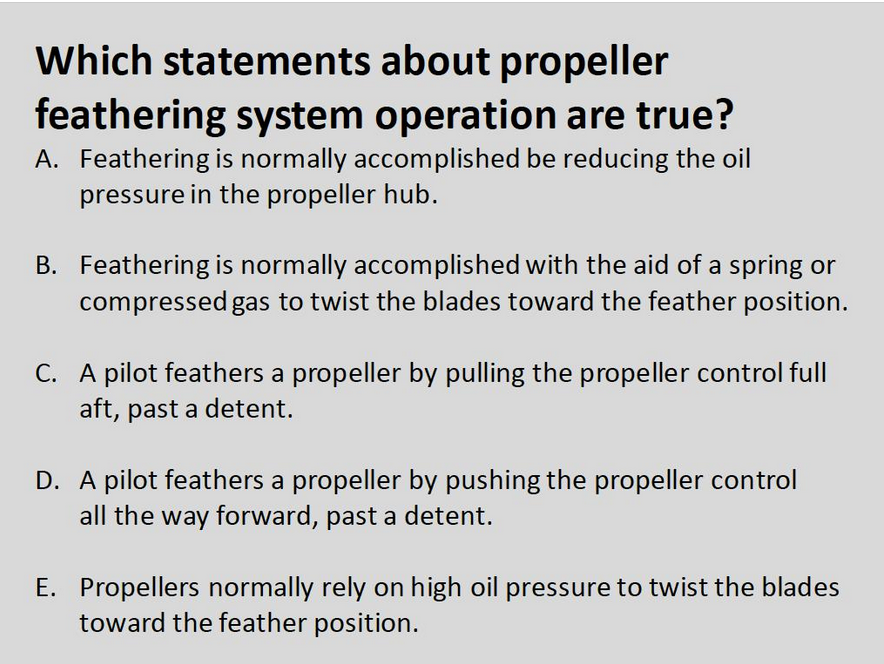
which statements about propeller feathering system operation are **true?**
a. feathering is normally accomplished by reducing the oil pressure in the propeller hub
b. feathering is normally accomplished with the aid of a spring or compressed gas to twist the blades towards the feather position
c. a pilot feathers a propeller by pulling the propeller control full aft, past a detent
b. feathering is normally accomplished with the aid of a spring or compressed gas to twist the blades towards the feather position
c. a pilot feathers a propeller by pulling the propeller control full aft, past a detent
19
New cards
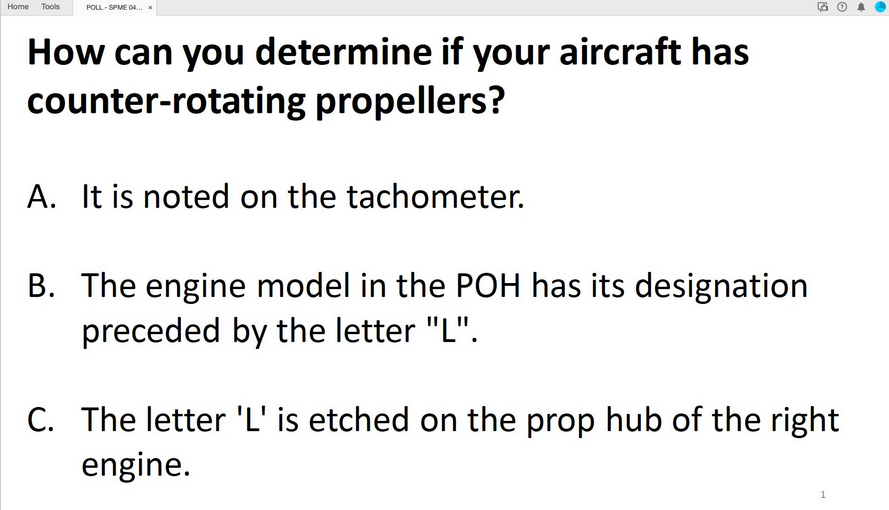
**how** can you determine if your aircraft has counter-rotating propellers?
b. the engine model in the **poh** has its designation preceded by the letter “L”
20
New cards
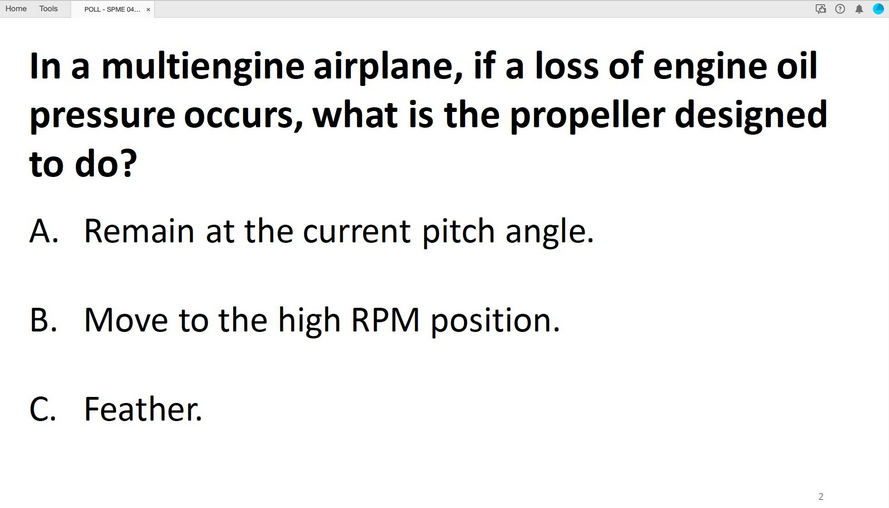
in a multiengine airplane, if a loss of oil pressure occurs, what is the propeller **designed to do?**
c. feather
21
New cards
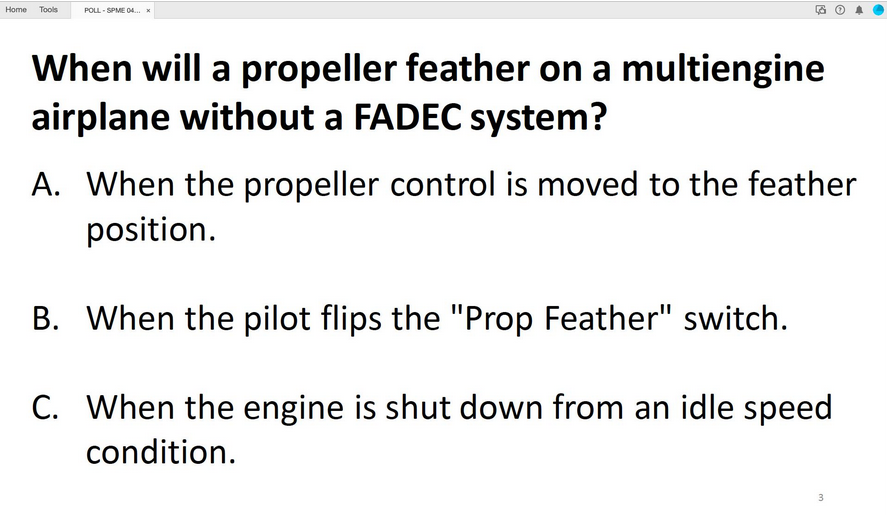
when will a propeller feather on a multiengine airplane without a **fadec** system?
a. when the prop control is moved to the feather position
22
New cards
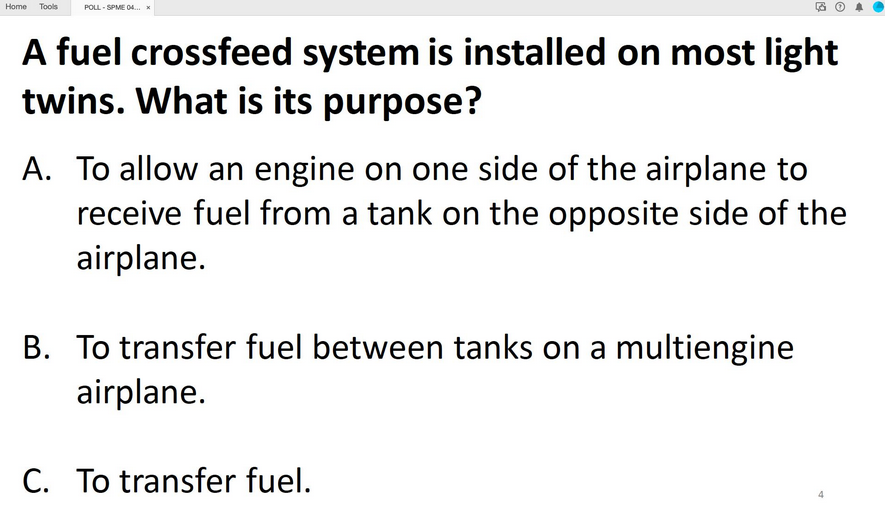
a **fuel crossfeed system** is installed on most light twins. what is its purpose?
a. to allow an engine on one side of the airplane to receive fuel from a tank on the opposite side of the airplane
23
New cards
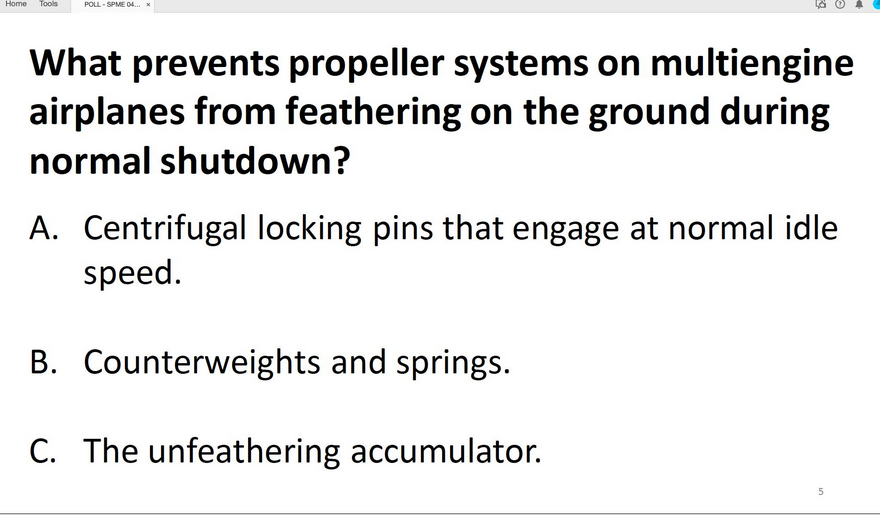
what prevents propeller systems on multiengine airplanes from feathering on the ground during normal shutdown?
a. centrifugal locking pins that engage at normal idle speed
24
New cards
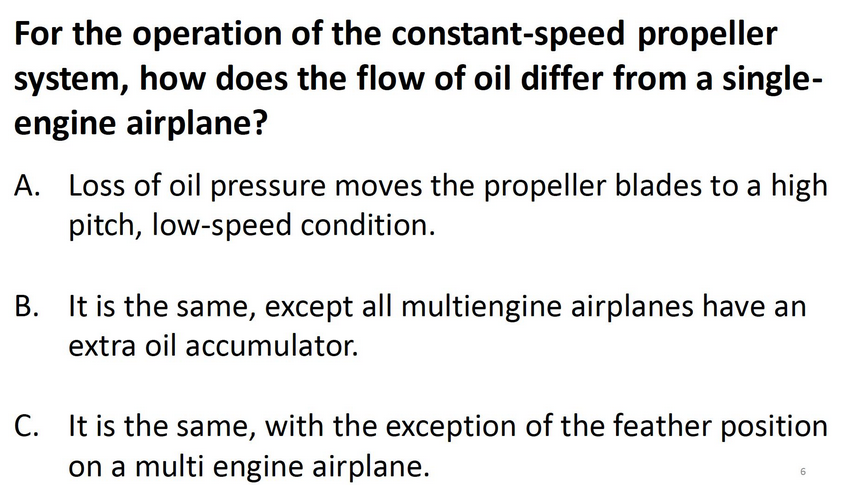
for the operation of the constant-speed propeller system, how does the **flow of oil** differ from a single-engine airplane?
a. loss of oil pressure moves the propeller blades to a high pitch, low-speed condition
25
New cards
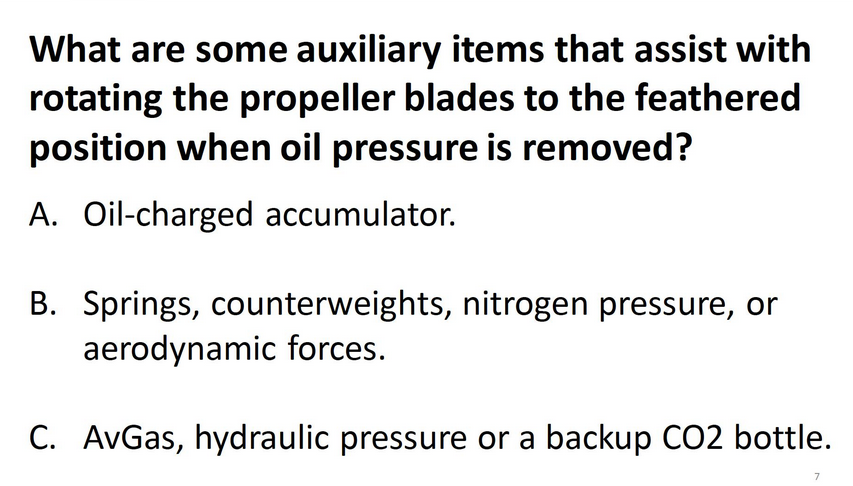
what are some **auxiliary items** that assist with rotating the propeller blades to the feathered position when oil pressure is removed?
b. springs, counterweights, nitrogen pressure, or aerodynamic forces
26
New cards
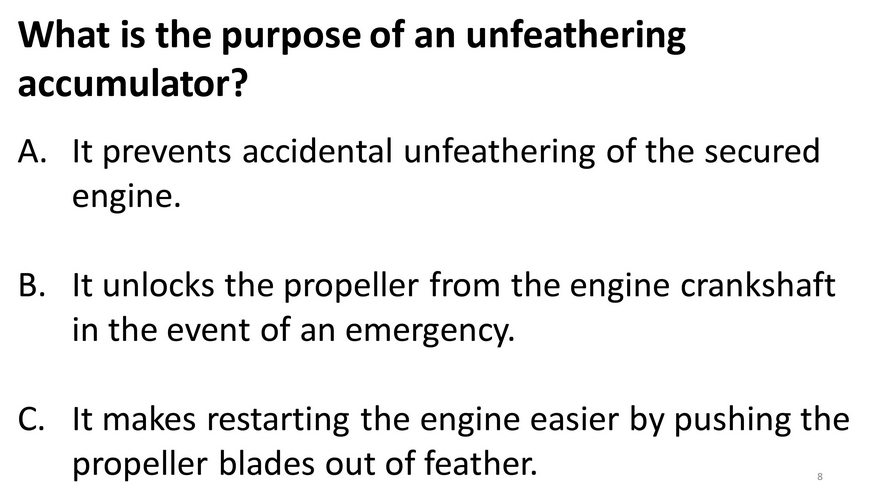
what is the purpose of an **unfeathering accumulator**
c. it makes restarting the engine easier by pushing the propeller blades out of feather
27
New cards
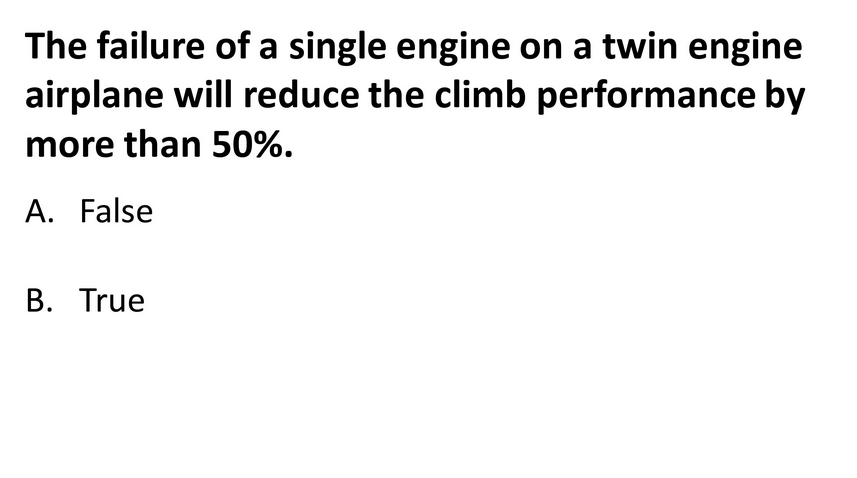
the failure of a single engine on a twin engine airplane will reduce the climb performance by more than 50%
b. true
28
New cards
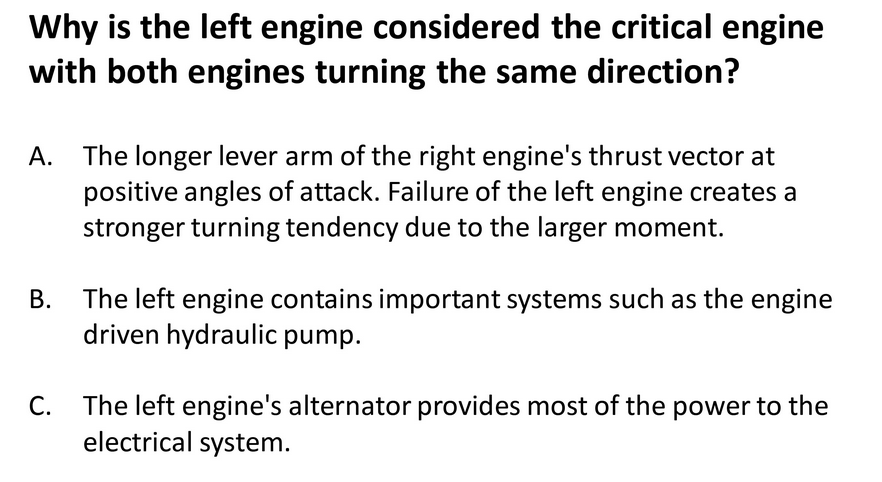
why is the left engine considered the critical engine with both engines turning the same direction?
a. the longer lever arm of the right engine’s thrust vector at positive angles of attack. failure of the left engine creates a stronger turning tendency due to the larger moment
29
New cards
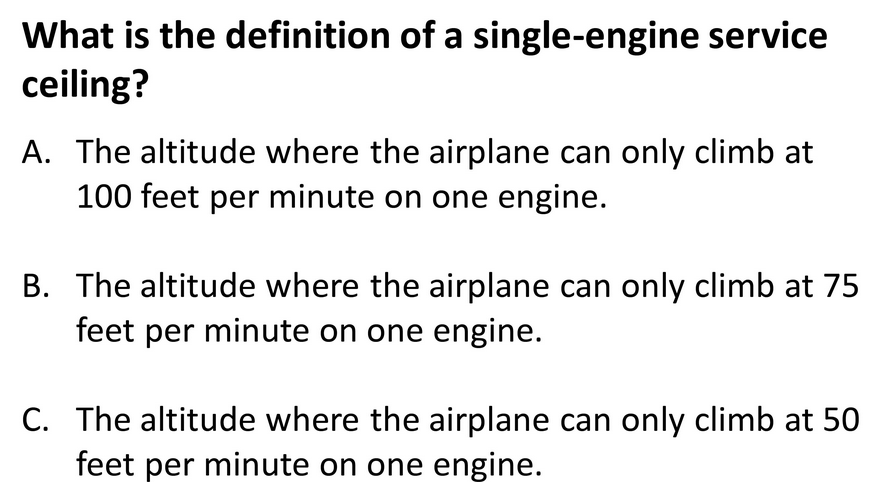
what is the definition of a single-engine service ceiling?
c. the altitude where the airplane can only climb at 50 feet per engine on one engine
30
New cards
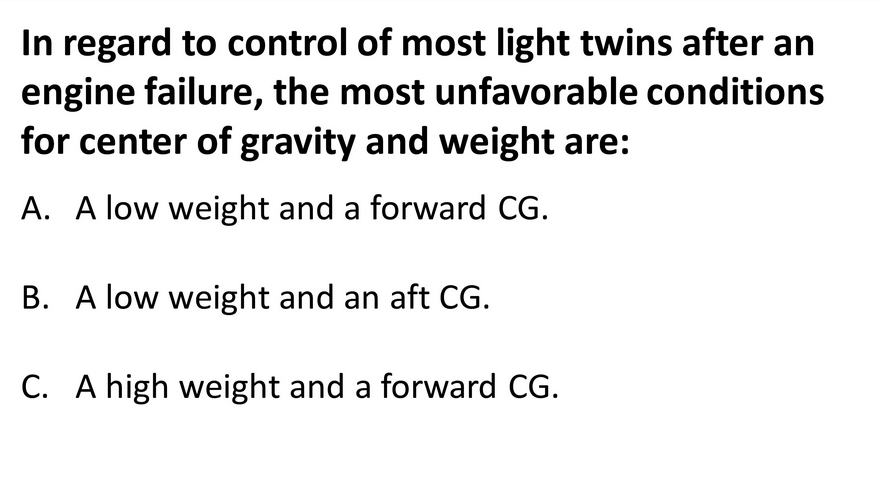
in regard to control of most light twins after an engine failure, the most unfavourable conditions for center of gravity and weight are
b. a low weight and an aft CG
31
New cards

the ability of an airplane to climb is a function of
a. excess horsepower
32
New cards
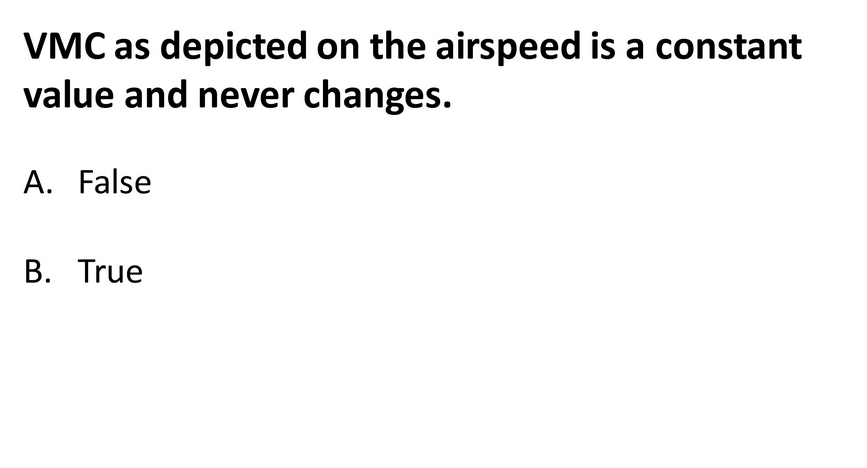
vmc as depicted on the airspeed is a constant value and never changes
a. false
33
New cards
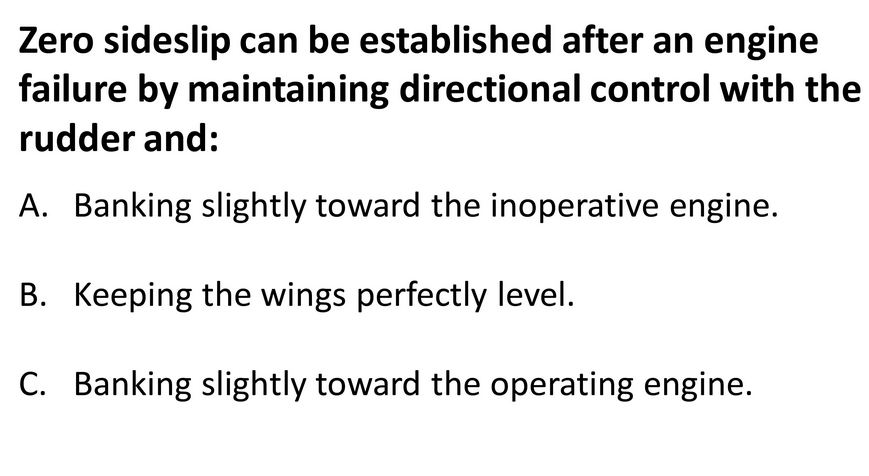
zero sideslip can be established after an engine failure by maintaining directional control with rudder and
c. banking slightly toward the operating engine
34
New cards
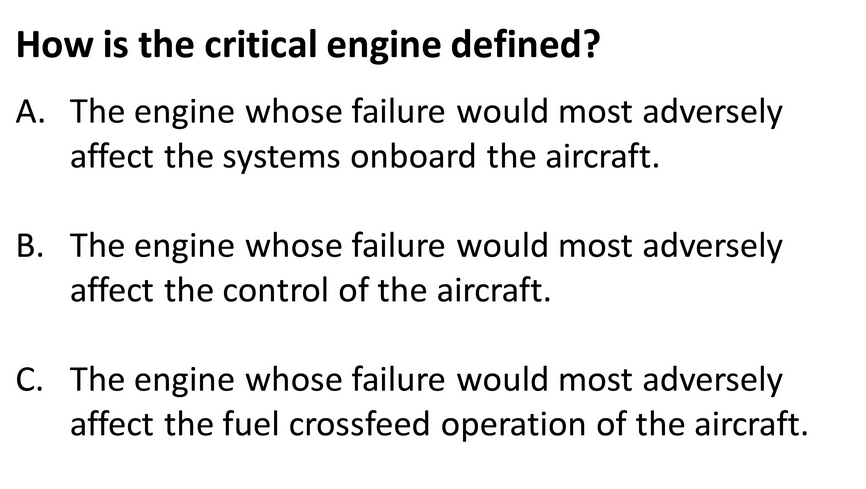
how is the critical engine defined?
b. the engine whose failure would most adversely affect the control of the aircraft
35
New cards

what is the definition of an absolute ceiling
c. it is the altitude where the climb rate reaches 0 feet per minute
36
New cards
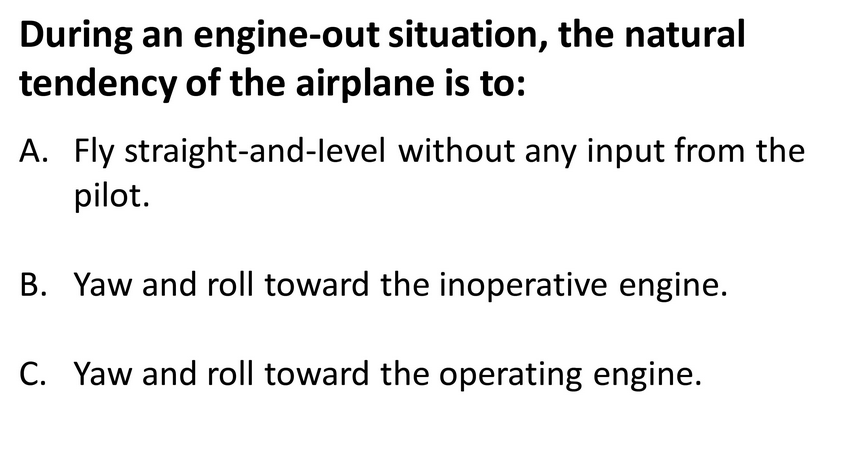
during an engine-out situation, the natural tendency of the airplane is to
b. yaw and roll towards the inoperative engine
37
New cards
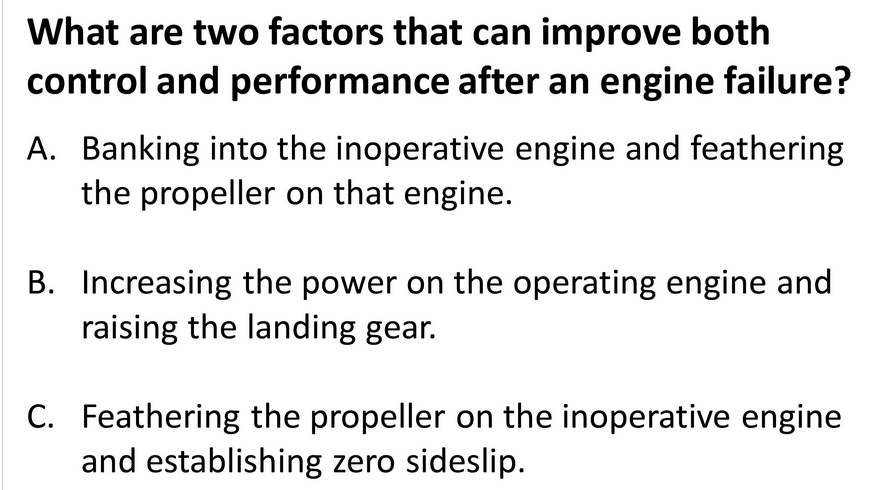
what are two factors that can improve both control and performance after an engine failure?
c. feathering the propeller on the inoperative engine and establishing zero sideslip
38
New cards
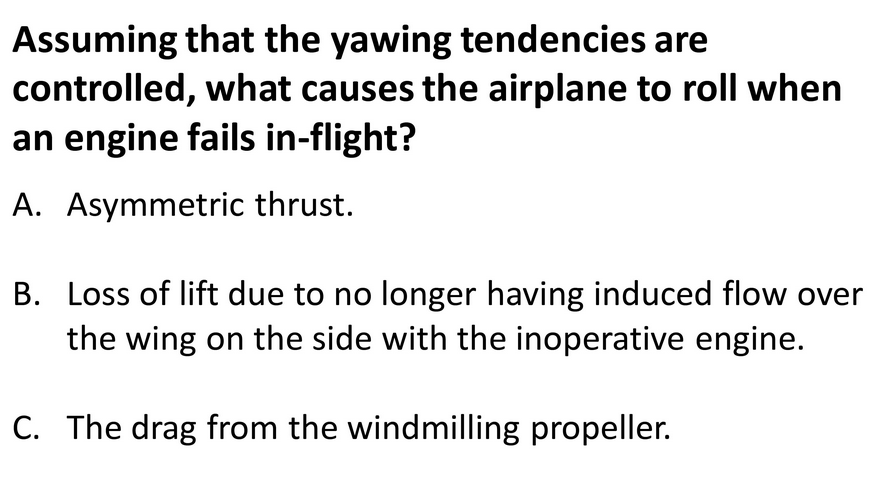
assuming that the yawing tendencies are controlled, what causes the airplane to roll when an engine fails in-flight?
b. loss of lift due to no longer having induced flow over the wing on the side with the inoperative engine
39
New cards
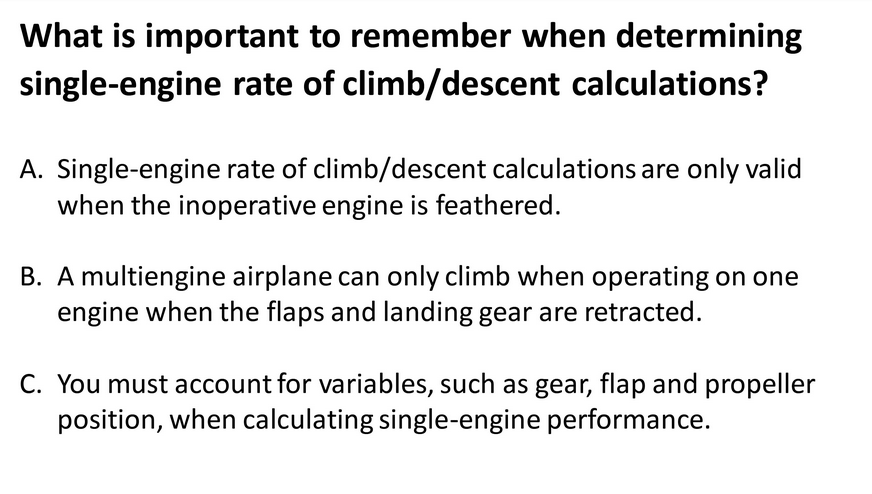
what is important to remember when determining single-engine rate of climb/descent calculations
c. you must account for variables, such as **gear, flap,** and **propeller position,** when calculating single-engine performance
40
New cards

how is accelerate-go defined
b. the aircraft starts out at 0 and accelerates to a specified speed. at the specified speed, an engine is assumed to fail and the takeoff is continued
41
New cards
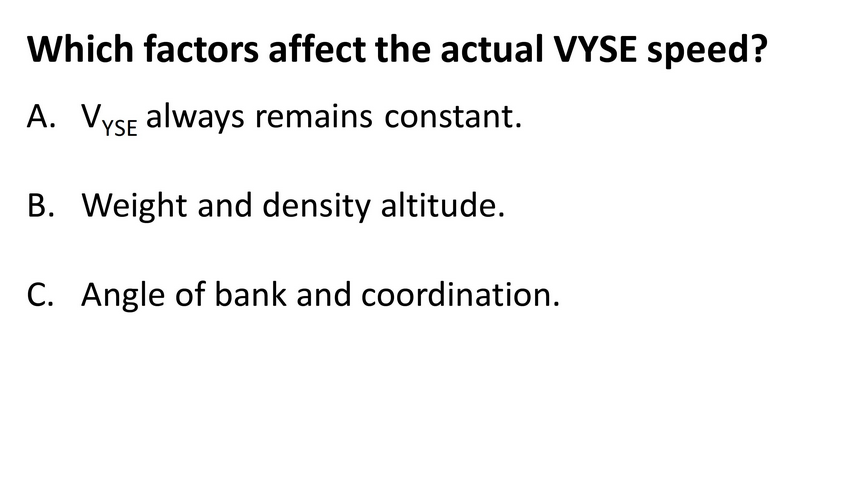
what factors affect the actual V**yse** speed?
b. weight and density altitude
42
New cards
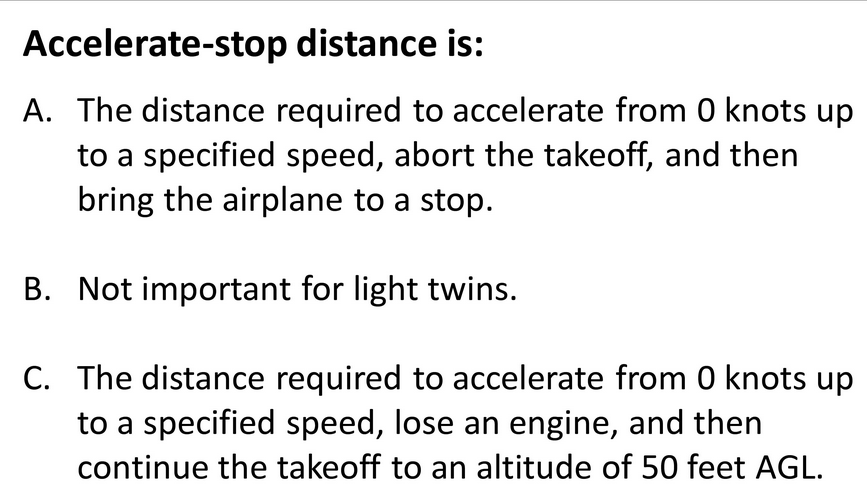
accelerate-stop distance is:
a. the distance required to accelerate from 0 knots up to a specified speed, abort the takeoff, and then bring the airplane to a stop
43
New cards
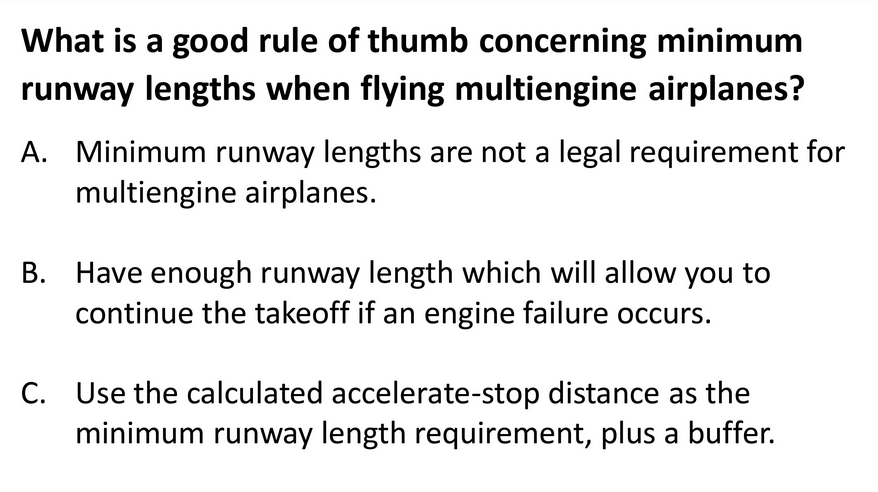
what is a good rule of thumb concerning minimum runway lengths when flying multiengine airplanes
c. use the calculated accelerate-stop distance as the minimum runway length requirement, plus a buffer
44
New cards
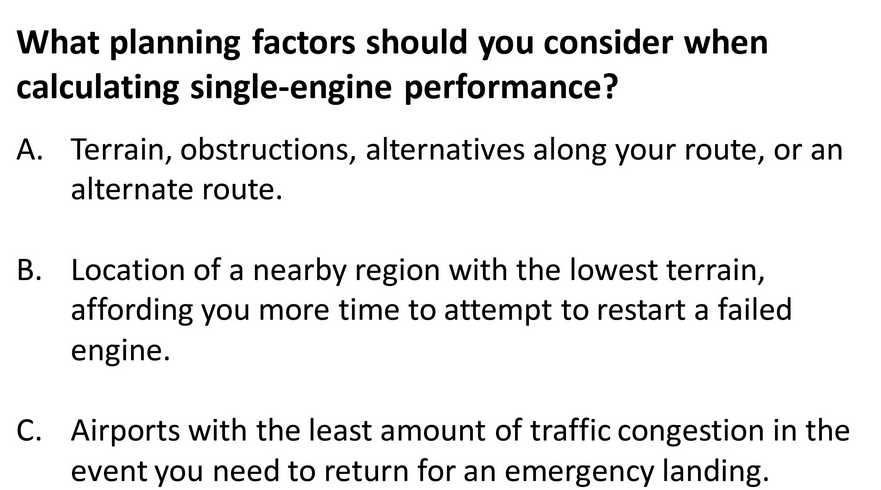
what planning factors should you consider when calculating single-engine performance?
a. terrain, obstructions, alternatives along your route, or an alternate route
45
New cards
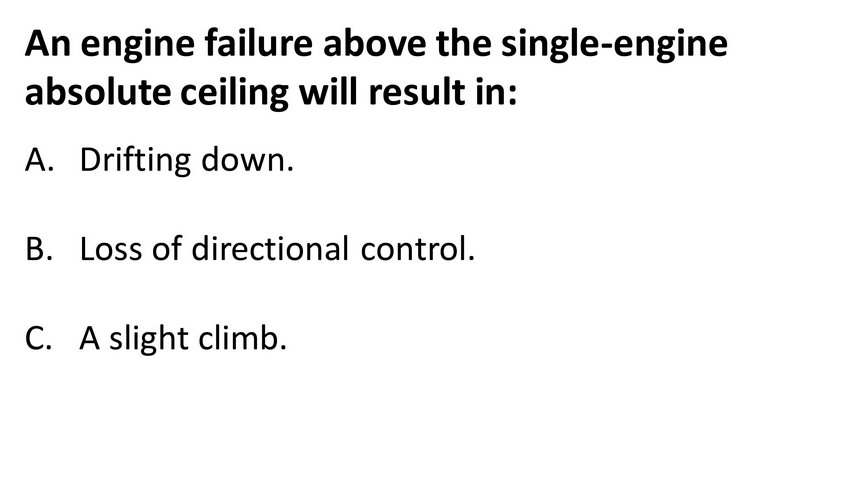
an engine failure above the single-engine absolute ceiling will result in:
a. drifting down
46
New cards
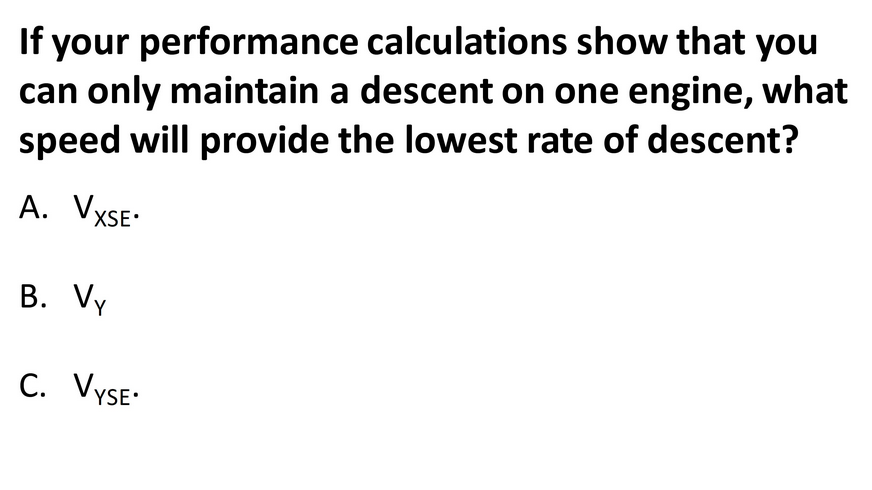
if your performance calculations show that you can only maintain a descent on one engine, what speed will provide the lowest rate of descent?
c. V**yse**
47
New cards

after feathering the propeller from an actual engine failure, attempting a restart is strongly discouraged.
b. true
48
New cards

the most important factor in handling an engine failure on a multiengine airplane is
c. aircraft control
49
New cards
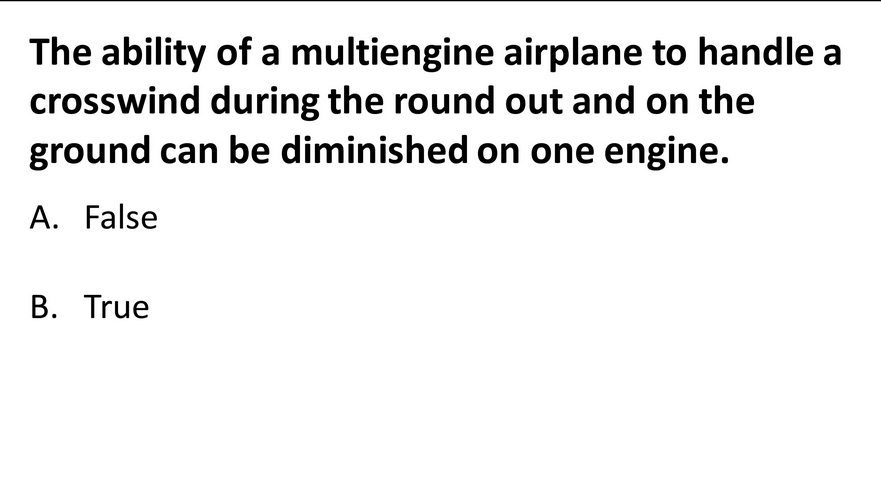
the ability of a multiengine airplane to handle a crosswind during the round out and on the ground can be diminished on one engine
b. true
50
New cards
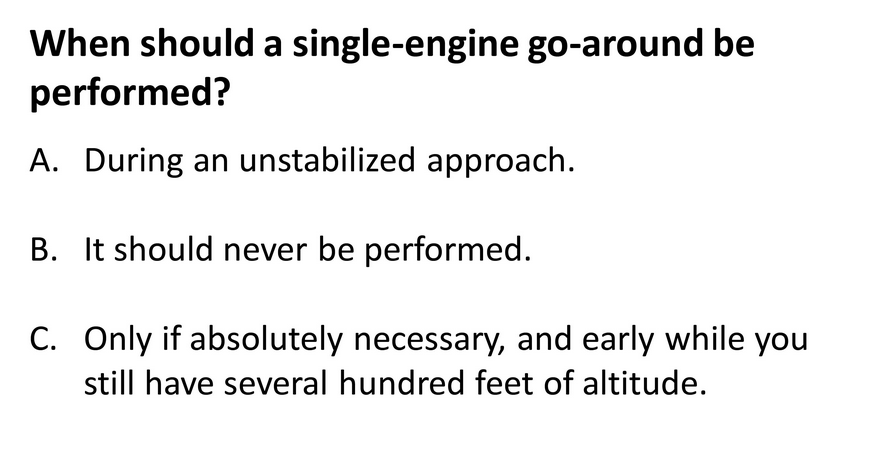
when should a single-engine go-around be performed?
c. only if absolutely necessary, and early while you still have several hundred feet of altitude.
51
New cards
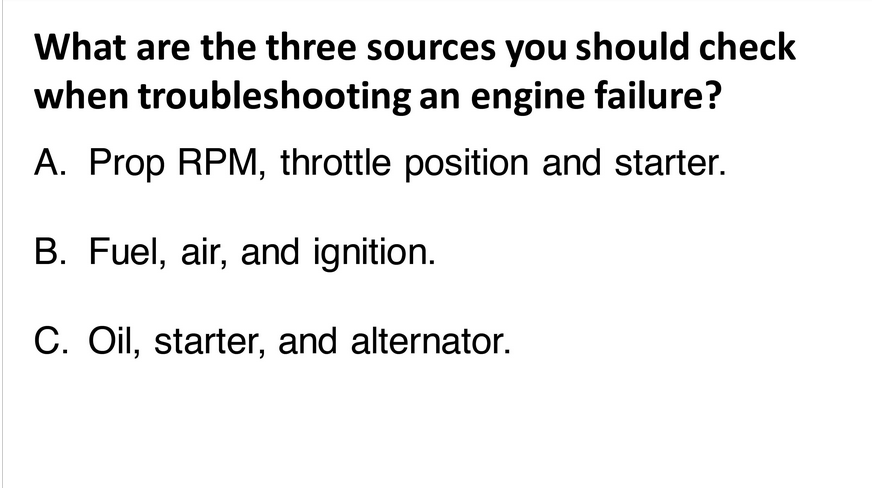
what are the three sources you should check when troubleshooting an engine failure?
b. fuel, air, and ignition
52
New cards
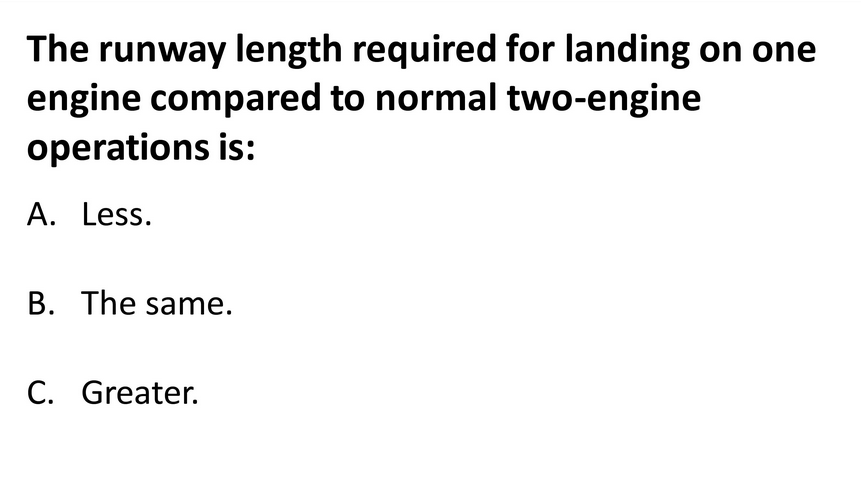
the runway length required for landing on one engine compared to normal two-engine operations is
c. greater
53
New cards
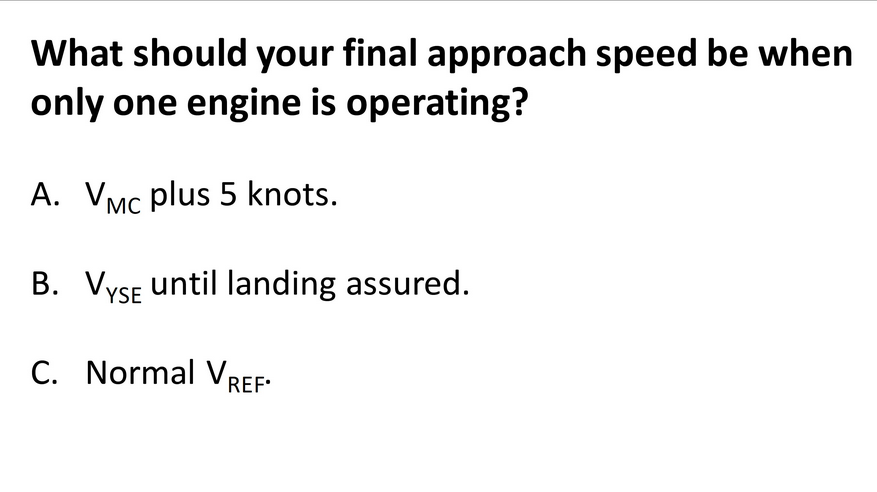
what should your final approach speed be when only one engine is operating?
b. V**yse** until landing is assured
54
New cards
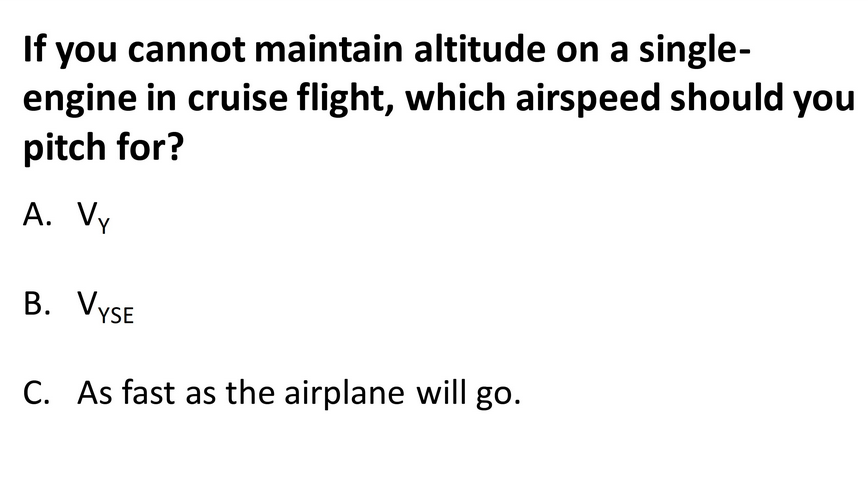
if you cannot maintain altitude on a single-engine in cruise flight, which airspeed should you pitch for?
b. V**yse**
55
New cards
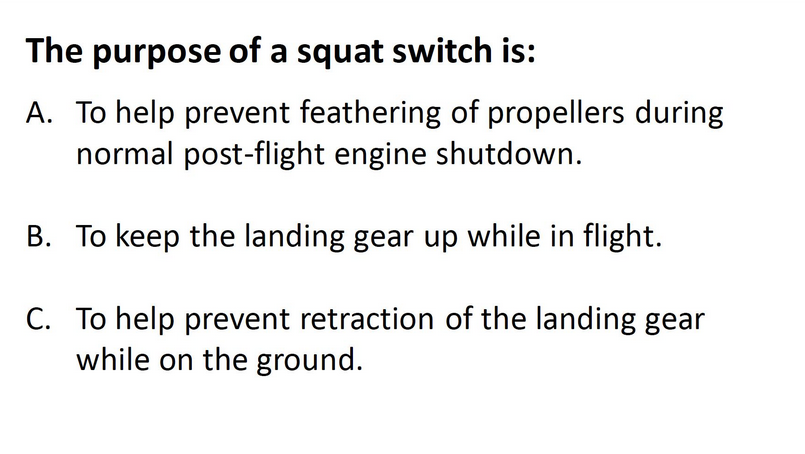
the purpose of a squat switch is
c. to help prevent retraction of the landing gear while on the ground
56
New cards
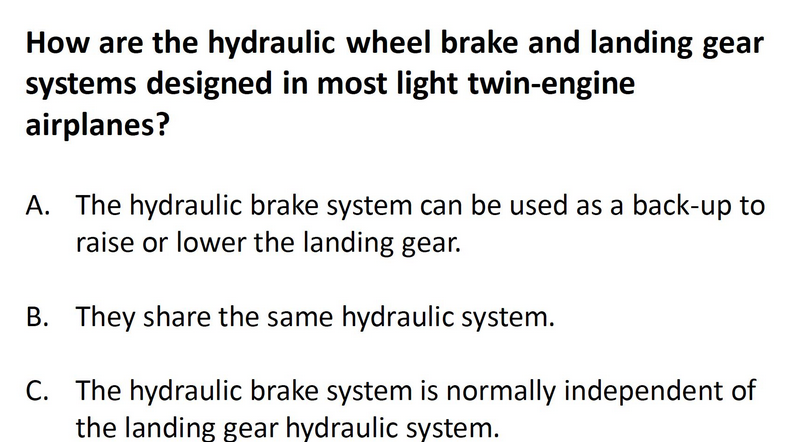
how are the hydraulic wheel brake and landing gear systems designed in most light twin-engine airplanes?
c. the hydraulic brake system is normally independent of the landing gear hydraulic switch
57
New cards
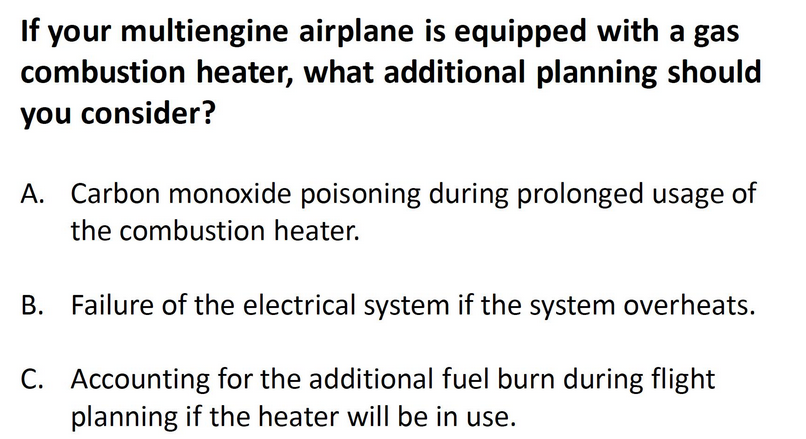
if your multiengine airplane is equipped with a gas combustion heater, what additional planning should you consider?
c. accounting for the additional fuel burn during flight planning if the heater will be in use
58
New cards
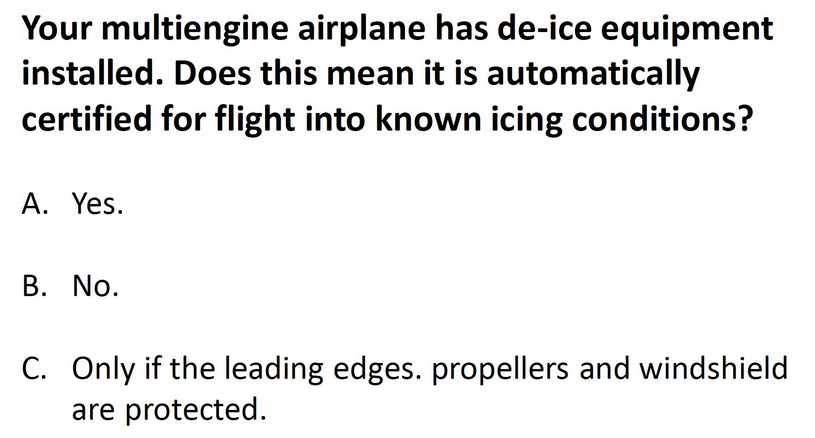
your multiengine airplane has de-ice equipment installed. does this mean it is automatically certified for flight into known icing conditions
b. no
59
New cards
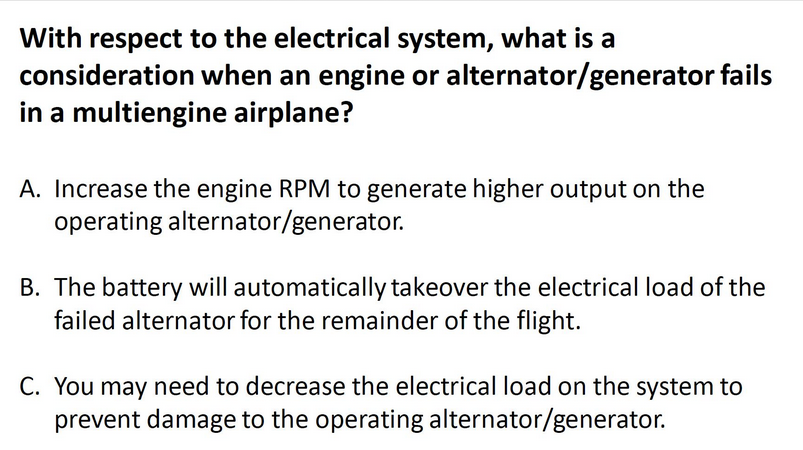
with respect to the electrical system, what is a consideration when an engine or alternator/generator fails in a multiengine airplane
c. you may need to decrease the electrical load on the system to prevent damage to the operating alternator/generator
60
New cards
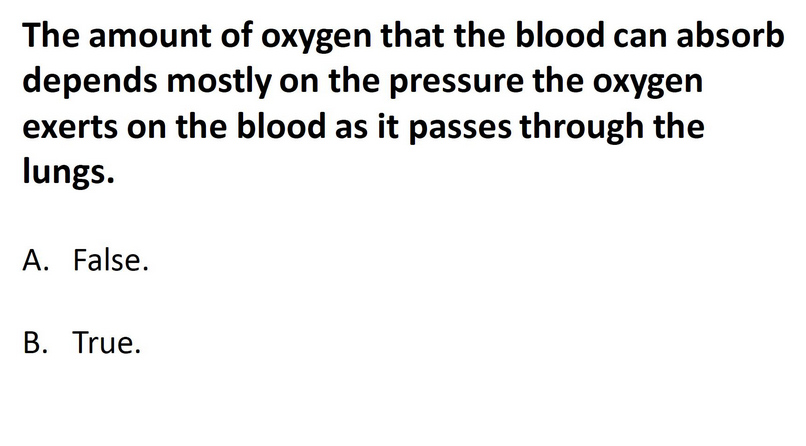
the amount of oxygen that the blood can absorb depends mostly on the pressure the oxygen exerts on the blood as it passes through the lungs
b. true
61
New cards
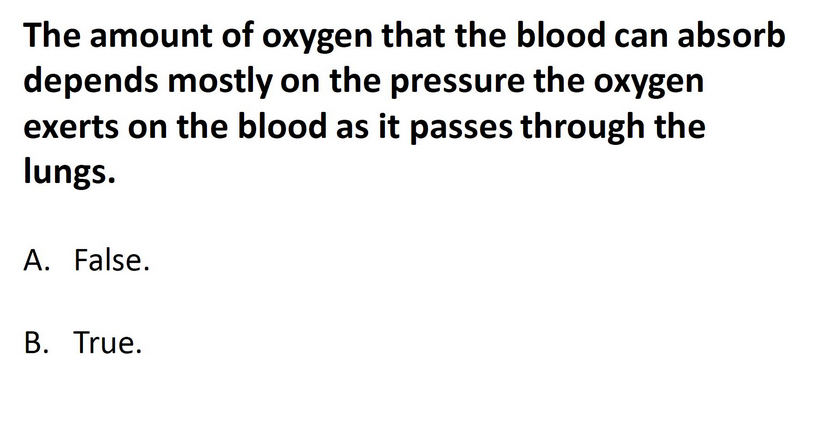
the amount of oxygen that the blood can absorb depends mostly on the pressure the oxygen exerts on the blood as it passes through the lungs
b. true
62
New cards
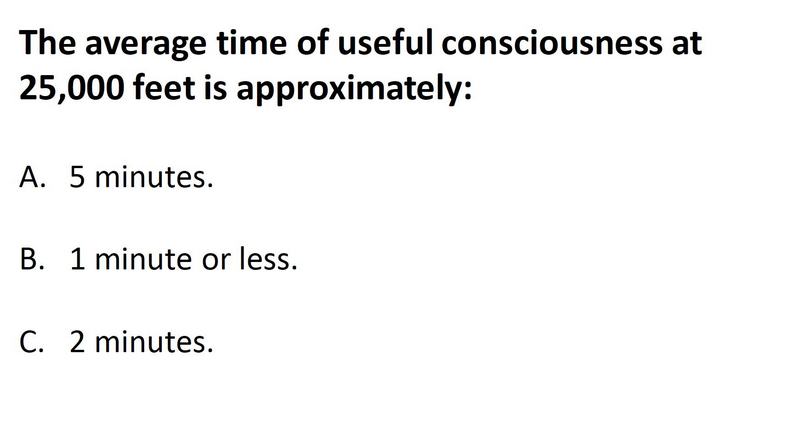
the average time of useful consciousness at 25,000 feet is approximately
c. 2 minutes
63
New cards
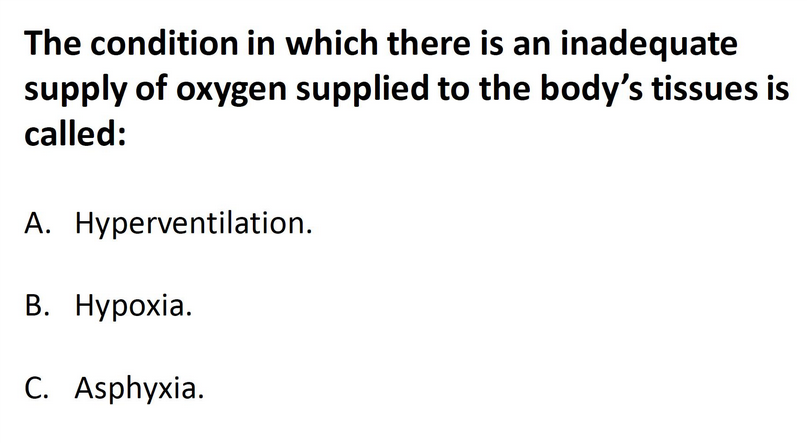
the condition in which there is an inadequate supply of oxygen supplied to the body’s tissues is called
b. hypoxia
64
New cards
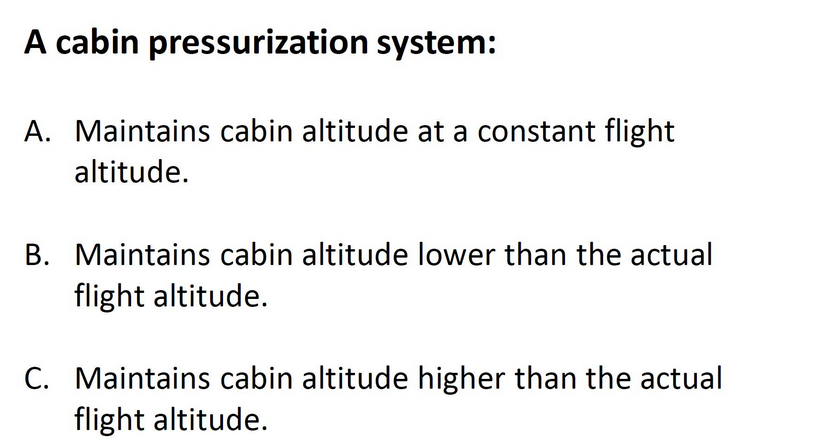
a cabin pressurization system
b. maintains cabin altitude lower than the actual flight altitude
65
New cards
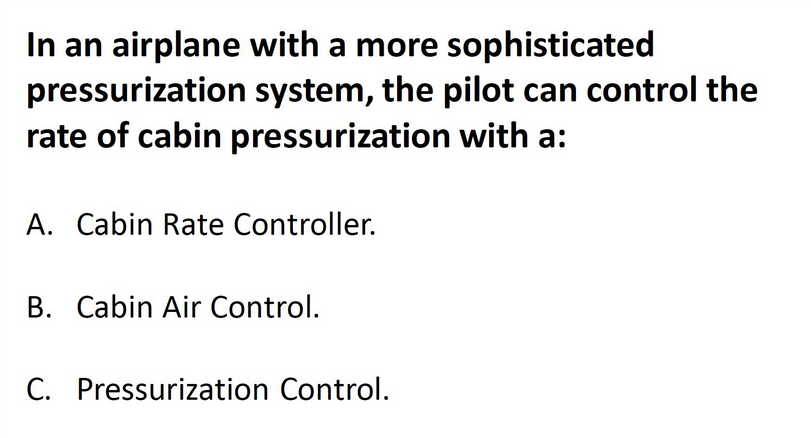
in an airplane with a more sophisticated pressurization system, the pilot can control the rate of cabin pressurization with a
a. cabin rate controller
66
New cards
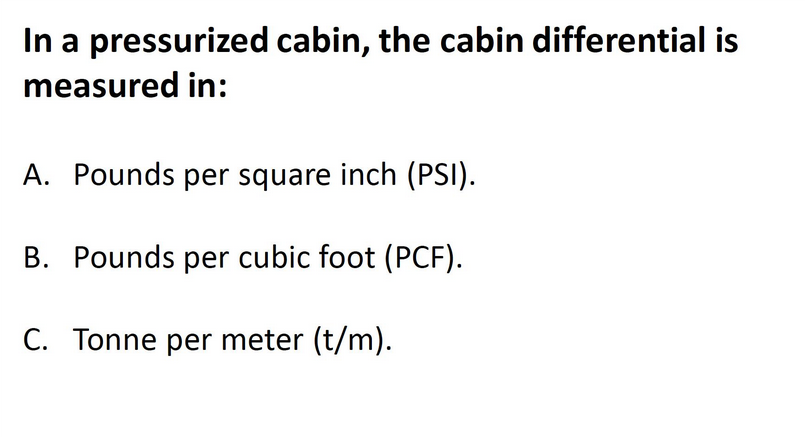
in a pressurized cabin, the cabin differential is measured in
a. pounds per square inch (psi)
67
New cards
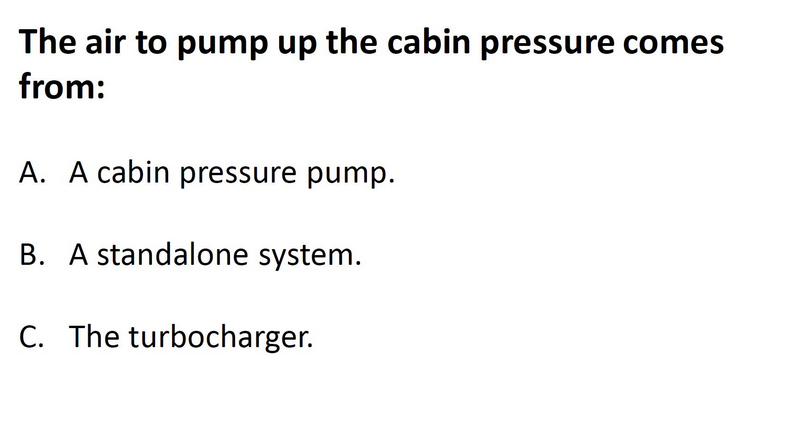
the air to pump up the cabin pressure comes from
c. the turbocharger